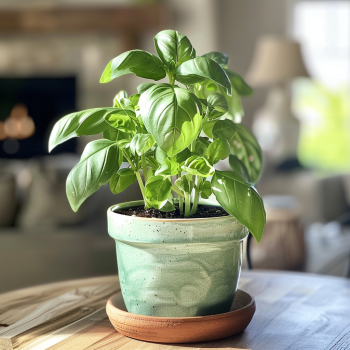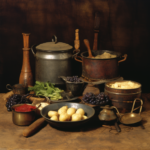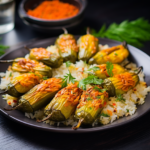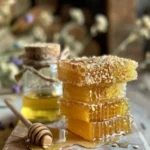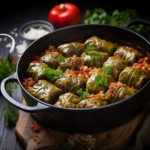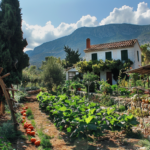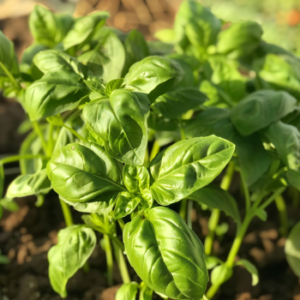
Have you ever dreamed of having a thriving basil patch right in your own backyard? Whether you’re an experienced gardener or just starting out, this guide will walk you through the secrets to successfully growing and harvesting this flavorful herb. Discover the key steps to cultivating fresh, aromatic basil that will elevate your culinary creations to new heights. But first, are you ready to uncover the hidden benefits of this versatile plant?
Basil Key Takeaways
- It is a fragrant, flavorful herb with a wide range of culinary and health benefits.
- Growing your own at home allows you to enjoy the freshest, most flavorful leaves.
- There are various varieties to choose from, each with unique characteristics and uses.
- Proper soil preparation, planting techniques, and ongoing care are crucial for a bountiful harvest.
- It can be preserved through drying or freezing to enjoy its flavors year-round.
Introduction to Basil
Basil (Ocimum basilicum) is an aromatic herb native to Southeast Asia and a member of the mint family. It is widely used in cooking for its distinctive, slightly sweet flavor. It is packed with beneficial compounds, including antioxidants, vitamins, and essential oils. Growing your own plant at home allows you to enjoy the freshest, most flavorful leaves, and provides a convenient way to incorporate this versatile herb into your cooking.
What is Basil?
It is a fragrant, leafy herb that is a staple in many cuisines, particularly Italian and Greek cooking. It is known for its vibrant green leaves and its ability to add a pop of flavor to a variety of dishes, from pastas and salads to pizzas and pesto.
Benefits of Growing Basil
Growing your own offers numerous benefits. Not only does it provide a steady supply of fresh, flavorful leaves, but it also allows you to control the growing conditions and ensure that your is free from pesticides or other chemicals. It is also packed with antioxidants, vitamins, and essential oils that can offer various health benefits, making it a nutritious addition to your diet.
|
Nutrient |
Basil’s Contribution |
|
Vitamin K |
It is an excellent source of vitamin K, providing over 100% of the recommended daily intake in just a few leaves. |
|
Vitamin A |
It contains carotenoids like beta-carotene, which are converted into vitamin A in the body, supporting eye health and immune function. |
|
Antioxidants |
It is rich in antioxidants, including eugenol, citronellol, and linalool, which can help protect cells from damage and reduce inflammation. |
|
Essential Oils |
It contains various essential oils, such as limonene and caryophyllene, which have been studied for their potential therapeutic uses. |
Choosing the Right Variety
When it comes to growing and cooking with basil, there are several distinct varieties to choose from, each offering its own unique flavor profile and culinary applications. Understanding the characteristics of the most popular varieties can help you select the best options for your garden and kitchen.
Sweet Basil
Sweet basil is the most widely recognized and commonly cultivated type of basil. This variety features large, tender leaves with a classic, slightly peppery flavor that is a staple in Italian and Mediterranean cuisines. Sweet basil is an excellent choice for making pesto, tomato-based sauces, and as a garnish for a wide range of dishes.
Lemon Basil
Lemon basil, as the name suggests, has a bright, citrusy aroma and flavor that pairs beautifully with seafood, poultry, and salads. This variety typically has smaller, more delicate leaves than sweet basil. Lemon basil is an excellent choice for adding a refreshing, zesty note to a wide range of culinary creations.
When selecting varieties for your garden or kitchen, consider the specific flavors and characteristics that will best complement your cooking style and the dishes you enjoy most. By exploring the diverse world of basil, you can find the perfect options to elevate your meals and unlock a world of culinary possibilities.
Preparing the Soil for Basil
Achieving a bountiful basil harvest starts with preparing the right soil conditions. Basil thrives in well-drained, nutrient-rich soil with a slightly acidic pH, typically between 6.0 and 7.5. To ensure your basil plants receive the nourishment they need, it’s essential to test the basil soil pH and make any necessary adjustments.
Soil pH and Nutrients
Before planting your basil, use a soil test kit to determine the pH level of your garden bed. If the soil is too acidic, add lime to raise the pH. Conversely, if the soil is too alkaline, you can lower the pH by incorporating sulfur. Maintaining the ideal soil requirements will help your plants absorb essential nutrients more effectively.
Amending the Soil
In addition to adjusting the pH, incorporating organic matter into the soil is crucial for growing healthy basil plants. Mix in compost, aged manure, or other nutrient-rich amendments to amend the soil and improve its structure. This will provide your basil with the necessary nutrients and enhance water retention, ensuring robust growth and a bountiful harvest.
|
Soil Amendment |
Benefits for Basil |
|
Compost |
Adds vital organic matter, improves soil structure, and provides a range of essential nutrients. |
|
Aged Manure |
Enriches the soil with nitrogen, phosphorus, and other essential minerals for robust plant growth. |
|
Perlite or Vermiculite |
Enhances drainage and aeration, preventing waterlogged conditions that can harm the plants. |
Planting Basil Seeds
It can be grown from seed, and the best time to plant will depend on your local climate. In most regions, it’s best to sow basil seeds indoors 4-6 weeks before the last expected frost date, then transplant the seedlings outside once the weather warms up.
When to Plant
Timing is crucial when it comes to when to plant . By starting seeds indoors and then transplanting the young plants outside, you can get a head start on the growing season and enjoy a bountiful harvest. Keep a close eye on your local frost predictions and plan accordingly.
Sowing Techniques
When sowing seeds, plant them about 1/4 inch deep and 12 inches apart, ensuring the soil is moist but not waterlogged. Provide plenty of sunlight and keep the soil consistently moist until the seeds germinate. Following these simple basil planting tips will give your plants the best possible start.
Caring for Basil Plants
Proper care is essential for maintaining healthy and productive plants. One of the key aspects of caring for basil is ensuring consistent watering. It thrives in consistently moist soil, so it’s important to water your plants regularly, making sure the soil stays evenly moist but not saturated.
Watering Requirements
The plants have a high water demand, especially during the hot summer months when they are actively growing. Aim to water your plants whenever the top inch of soil begins to dry out, providing enough water to thoroughly moisten the soil without causing it to become waterlogged. Consistent, even watering is crucial for promoting lush, robust growth and preventing issues like wilting or yellowing leaves.
Pruning and Pinching
To encourage bushier growth and prevent your basil plants from going to seed, regular pruning and pinching is recommended. Regularly snip off the stem tips, removing any flower buds that form. This will redirect the plant’s energy into producing more leaves, giving you a continuous harvest throughout the growing season. Be sure to prune or pinch just above a set of healthy leaves or leaf nodes, leaving 6-8 inches of stem.
Pest and Disease Management
Basil plants can be susceptible to a few common basil pests and basil diseases, such as aphids, spider mites, and downy mildew. Regularly inspecting your plants and addressing any issues promptly is crucial for maintaining a healthy and productive crop. When it comes to pest control, organic pest control for basil is the preferred approach, as it is safer for both you and the environment.
Identifying Pests and Diseases
Familiarize yourself with the common basil pests and basil diseases that may affect your plants. Look for signs of aphid infestations, characterized by small, sap-sucking insects clustering on the leaves and stems. Spider mites can also be problematic, leaving behind fine webbing and discolored, distorted foliage. Downy mildew, a fungal disease, will cause yellowing and wilting of the leaves, with a fuzzy, grayish-purple growth on the undersides.
Organic Pest Control Methods
When dealing with pests or diseases, opt for organic pest control for basil whenever possible. Some effective and environmentally friendly methods include handpicking pests, using insecticidal soap, or applying neem oil. Maintaining good air circulation and avoiding overwatering can also help prevent many basil-related problems. By taking a proactive and organic approach to pest and disease management, you can ensure a bountiful and healthy harvest.
Harvesting Basil
The best time to harvest is in the morning, after the dew has dried but before the sun’s heat becomes intense. This is when the leaves are at their most flavorful and aromatic. To harvest, simply snip the leaves just above a set of healthy leaves or leaf nodes, leaving 6-8 inches of stem. This encourages the plant to continue producing new growth, ensuring a bountiful basil harvesting throughout the growing season.
When to Harvest
The ideal time to harvest basil is in the morning, as mentioned, when the essential oils are most concentrated in the leaves. This provides the best flavor and aroma for your culinary creations. Aim to harvest basil regularly, every 1-2 weeks, to keep the plants healthy and productive.
Harvesting Techniques
When harvesting basil, use sharp, clean scissors or pruning shears to snip the leaves just above a set of healthy leaves or leaf nodes. Leave about 6-8 inches of stem on the plant to encourage new growth. Avoid cutting the main stem too low, as this can damage the plant. Harvest the leaves regularly, removing any flower buds that form to direct the plant’s energy into producing more flavorful foliage.
Preserving Basil
To enjoy the flavors of your homegrown basil year-round, you can preserve it through drying or freezing. These methods are excellent for preserving basil and ensuring you can enjoy its vibrant taste long after the growing season has ended.
Drying Basil
For drying, simply hang bunches of basil in a warm, dry place out of direct sunlight. Once the leaves are crisp, store them in an airtight container. This method is a great way to dry and keep it fresh for use in your favorite recipes throughout the year.
Freezing Basil
Freezing basil is another excellent option for preserving. Chop the leaves and freeze them in ice cube trays filled with water or olive oil, then transfer the cubes to a freezer-safe bag or container. This allows you to easily incorporate the frozen basil into sauces, soups, and other dishes, even when the fresh herb is out of season.
FAQ
What is Greek cuisine?
Greek cuisine is the traditional cuisine of Greece and the Greek people. It is based on the Mediterranean diet, which is characterized by the use of olive oil, grains, beans, vegetables, cheese, fish, and meat.
What are some common ingredients in Greek cuisine?
Some common ingredients in Greek cuisine include olive oil, feta cheese, yogurt, lemon, herbs (such as oregano, mint, and parsley), grains (such as rice, wheat, and barley), legumes (such as chickpeas and lentils), vegetables (such as tomatoes, eggplants, and zucchini), and seafood (such as fish, shrimp, and octopus).
What are some popular Greek dishes?
Some of the most popular Greek dishes include moussaka (a layered dish of eggplant, ground meat, and béchamel sauce), souvlaki (skewered and grilled meat), tzatziki (a creamy cucumber and yogurt dip), spanakopita (a spinach and feta cheese pie), and Greek salad (a fresh salad made with tomatoes, cucumbers, onions, olives, and feta cheese).
How does Greek cuisine differ from other Mediterranean cuisines?
Greek cuisine has some unique characteristics that set it apart from other Mediterranean cuisines. For example, it often features more lemon, herbs, and garlic in its dishes, and it makes greater use of specific ingredients like feta cheese, olives, and olive oil. Greek cuisine also has a strong focus on seafood and vegetable-based dishes.
What are the health benefits of Greek cuisine?
Greek cuisine is often considered one of the healthiest in the world due to its emphasis on plant-based foods, healthy fats, and minimal processing. The Mediterranean diet, which is closely tied to Greek cuisine, has been linked to numerous health benefits, including reduced risk of heart disease, diabetes, and certain types of cancer.
How has Greek cuisine evolved over time?
Greek cuisine has a long and storied history, with influences from various civilizations that have occupied the region over the centuries. While traditional Greek dishes remain popular, the cuisine has also evolved to incorporate some modern and international culinary trends, such as the increasing use of organic and locally sourced ingredients.
What role does Greek cuisine play in the country’s culture and identity?
Greek cuisine is deeply intertwined with the country’s cultural identity and traditions. Sharing and enjoying meals together is an integral part of Greek social life, and many traditional Greek dishes are tied to specific holidays, celebrations, and regional customs. The preparation and consumption of Greek food is a way for the Greek people to preserve and pass down their cultural heritage.
Greek Herbs
- Top Ten Greek Herbs: Learn about the essential herbs that define Greek cuisine.
- Growing Greek Oregano Plants: Discover how to cultivate flavorful Greek oregano in your garden.
- Thyme in Greek Cuisine: Explore the diverse uses of thyme in traditional Greek dishes.
- Rosemary: Uncover the secrets of using rosemary in Greek cooking.
- Dill in Greek Cuisine: Delve into the culinary applications of dill in Greek culinary traditions.
Celebrity Chefs on Chef on a Bike YouTube
Greek TV Chef Anna-Maria Barouh
Facebook: Anna-Maria Barouh
Instagram: annamariabarouh
Celebrity Chef, Food Stylist, Recipe Developer Anna Maria Barouh is our guest on Chef on a Bike. Anna-Maria is a regular on Greek Television and has a very popular food blog and is a magazine contributor.
- YouTube Episode: Chef on a Bike YouTube Episode






